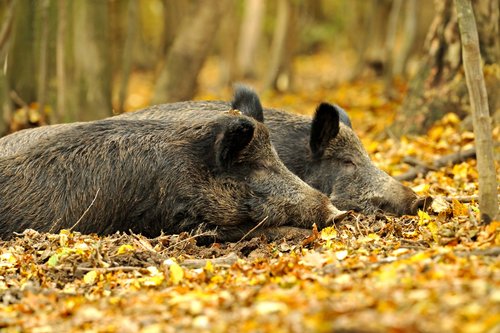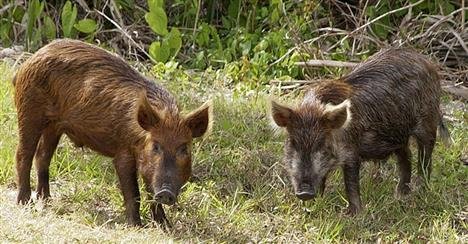Thermal Imaging Technology: A Game-Changer in Hunting and Beyond
Thermal imaging devices have revolutionized the way we perceive and interact with our surroundings, providing us with an advanced perspective that goes beyond the limitations of human vision. These remarkable tools utilize thermal radiations emitted by objects to create a visual representation of their heat distribution, unveiling a realm invisible to the naked eye.
Whether you are an avid hunter, a wildlife enthusiast, or simply someone intrigued by cutting-edge technology, exploring the world of thermal imaging devices is sure to captivate your senses. When it comes to evaluating thermal imaging devices, several key factors must be considered to ensure optimum performance and functionality.
First and foremost is the intended use of the device. While some individuals prioritize thermal imaging for hunting purposes, others may require it for surveillance, home security, or even search and rescue operations.
Each application demands specific features and capabilities tailored to its unique requirements. For hunters seeking to harness the power of thermal optics in their pursuit of game animals like hogs, understanding the different types of thermal imaging devices available is crucial.
The market offers a range of options including monoculars, binoculars, scopes, and even clip-on attachments for existing optical equipment. Each variation has its own advantages and limitations when it comes to thermal resolution and detection range.
Assessing thermal resolution is vital in determining how clearly objects can be detected and differentiated in a thermographic image produced by these devices. This aspect dictates not only the level of detail visible but also provides insight into how effectively targets can be identified at varying distances.
Additionally, detection range plays a vital role as it determines how far away heat signatures can be detected accurately. In order for any user to fully benefit from these advanced tools while out in the field or on extended hunting trips, user-friendly features and controls are paramount.
Efficient menu systems that allow easy access to various settings such as color palettes or image enhancement modes can significantly enhance usability without compromising performance. Moreover, battery life and durability are essential considerations for those relying on thermal imaging devices during extended periods in rugged environments.
Having a device that can withstand harsh weather conditions, accidental drops, and prolonged use without sacrificing performance is crucial. To truly gauge the effectiveness of thermal imaging devices for hog hunting or any other application, it is invaluable to delve into real-life reviews and experiences shared by hunters who have put these tools to the test in the field.
Such insights provide valuable firsthand information about the practicality, reliability, and overall satisfaction with various thermal imaging devices. Thermal imaging devices offer a world of possibilities beyond our natural senses and have become an invaluable tool for hunters, outdoor enthusiasts, and professionals alike.
By carefully assessing key factors such as intended use, thermal resolution, detection range, user-friendly features, battery life, durability, and real-life reviews of thermal hunting tools; one can make an informed decision when selecting a device that best suits their needs. So join us as we embark on this journey to unravel the wonders of thermal imaging technology and explore its endless potential in enhancing our understanding and experience of the world around us.
Factors to Consider When Evaluating Thermal Imaging Devices
When it comes to evaluating thermal imaging devices, there are several crucial factors that one must consider. These factors play a significant role in the overall performance and effectiveness of the device, ensuring that users can make an informed decision based on their specific requirements. The key factors to consider while assessing thermal optics include resolution, detection range, and clarity of image.
Resolution is arguably one of the most critical aspects when it comes to thermal imaging devices. Higher resolution equates to a more detailed and accurate representation of heat signatures, allowing for better target identification and tracking.
Devices with higher resolutions provide crisp images that aid in distinguishing between objects and identifying potential targets more easily. It is recommended to opt for devices with a resolution of at least 320×240 pixels or higher for optimal performance during hog hunting expeditions.
Another important factor to consider is the detection range offered by the thermal imaging device. The detection range determines how far the device can detect heat signatures effectively.
This is particularly crucial in hog hunting as it allows hunters to spot hogs from a distance, giving them ample time to prepare for approaching targets. Devices with longer detection ranges enable hunters to cover larger areas without compromising accuracy or efficiency.
Clarity of image plays a vital role in evaluating thermal imaging devices as well. A clear image ensures that hunters can distinguish between individual animals or targets within a group accurately.
Evaluating this factor involves examining factors such as image noise, contrast level adjustments, and overall visual quality provided by the device’s display technology. A high-quality display will present clear images even in challenging lighting conditions or adverse weather scenarios.
When assessing thermal optics for hog hunting purposes, several factors should be taken into account including resolution, detection range, and clarity of image. By carefully considering these aspects during the evaluation process, hunters can ensure they select a reliable and efficient thermal imaging device that meets their specific needs during hog hunting expeditions.
Types of Thermal Imaging Devices for Hog Hunting
When it comes to hog hunting, selecting the right thermal imaging device is crucial for achieving success in the field. There are several types of thermal imaging devices available, each with its own unique features and capabilities. In this section, we will explore the different options and their suitability for hog hunting.
One popular type of thermal imaging device used for hog hunting is the handheld monocular. These compact and portable devices are designed to be easily carried and provide a clear view of your surroundings.
Handheld monoculars offer a wide field of view, allowing hunters to scan larger areas quickly. They often come equipped with image enhancement technologies that enhance clarity in low-light conditions, making them an excellent choice for tracking hogs during nighttime hunts.
Additionally, many handheld monoculars offer zoom capabilities, allowing hunters to focus on specific areas or targets. Another type of thermal imaging device commonly used for hog hunting is the rifle-mounted scope.
These scopes attach directly to your firearm and provide real-time thermal images through the scope’s reticle. Rifle-mounted scopes offer precise targeting and aiming capabilities, making them ideal for accurately tracking hogs in various terrains.
Many models feature ballistic calculators that can calculate bullet drop compensation based on distance, wind conditions, and other factors. This feature greatly enhances accuracy and reduces guesswork when taking shots at moving targets.
For hunters who prefer a more immersive experience, helmet-mounted thermal goggles or binoculars are a popular choice. These devices allow hunters to have hands-free operation while providing a wide field of view similar to handheld monoculars or binoculars but without having to carry any additional equipment separately.
Helmet-mounted systems typically offer high-resolution displays that deliver crisp thermal imagery directly into the hunter’s line of sight. When evaluating thermal imaging devices for hog hunting purposes, it is important to consider factors such as portability, image quality enhancement technologies like zoom capabilities or image stabilization features (if applicable), compatibility with your firearm, and ease of use.
Handheld monoculars, rifle-mounted scopes, and helmet-mounted goggles or binoculars are among the most common types of thermal imaging devices used for hog hunting, each offering unique benefits and features. It is recommended to do thorough research, read reviews of thermal hunting tools, and assess thermal optics’ performance before making a final decision on the best device for your specific needs.
Analyzing Thermal Resolution and Detection Range
When it comes to assessing thermal optics for hunting purposes, two critical factors that demand careful consideration are thermal resolution and detection range. The thermal resolution of a device refers to its ability to detect and display minute differences in temperature.
Higher resolution allows for greater detail, offering a clearer picture of the environment. In terms of thermal resolution, most devices on the market fall into two categories: low-resolution and high-resolution.
Low-resolution devices typically have a pixel count between 160×120 and 320×240 pixels, while high-resolution models boast pixel counts ranging from 640×480 pixels and above. Naturally, higher resolution yields more precise images and better target identification capabilities.
Additionally, detection range plays a crucial role in determining the effectiveness of a thermal imaging device during hunting expeditions. Detection range refers to the maximum distance at which an object or heat signature can be detected by the device.
This factor is influenced by various elements such as weather conditions, environmental factors (e.g., foliage density), target size, and heat emissions. When reading reviews of thermal hunting tools or consulting manufacturers’ specifications, it’s essential to consider real-world scenarios rather than relying solely on idealized conditions provided by manufacturers.
While some devices claim detection ranges exceeding thousands of yards under optimal circumstances, practical usage may yield different results depending on the aforementioned variables. Therefore, it is advisable to look for reviews from experienced hunters who have tested these devices in diverse environments to get a more accurate understanding of their actual performance.
When evaluating thermal imaging devices for hunting purposes, analyzing their thermal resolution and detection range provides valuable insights into their functionality in real-world scenarios. Higher resolutions allow for better target identification due to enhanced image clarity and detail.
Simultaneously, understanding the limitations of detection range ensures realistic expectations when using these tools in different environments with varying conditions. It is crucial to rely on comprehensive reviews from reputable sources or firsthand experiences to gain an accurate understanding of how these factors truly impact the performance of thermal imaging devices in hunting applications.
User-Friendly Features and Controls
When it comes to user-friendly features and controls, thermal imaging devices for hog hunting have come a long way in terms of technological advancements. Manufacturers recognize the importance of providing intuitive interfaces that make operating these devices effortless, especially in fast-paced hunting situations.
One key aspect to consider is the ease of navigation within the device’s menu system. The ability to quickly access different settings and adjust parameters on the go can greatly enhance the overall user experience.
Another important factor to evaluate is the quality and layout of the device’s display screen. A clear, high-resolution screen is essential for effectively interpreting thermal images in real-time during hog hunting expeditions.
Additionally, a well-designed interface that provides clear icons and symbols can significantly improve usability under low-light conditions or when wearing gloves. Some thermal imaging devices even offer customizable color palettes, allowing users to tailor the image presentation according to their preferences or specific hunting scenarios.
Ergonomics also play a crucial role in ensuring user-friendliness. Thermal imaging devices designed with comfort in mind will feature well-placed buttons and controls that are easily accessible without requiring excessive hand movements or adjustments while using other equipment such as firearms or binoculars.
A good grip design is also important, as it allows for a secure hold during intense hunts without causing fatigue or discomfort. To get an accurate assessment of user-friendliness, it is beneficial to read reviews of thermal hunting tools from experienced hunters who have extensively used different models in various environments.
These reviews often highlight how well certain devices perform under challenging conditions such as low temperatures, rain, or foggy environments. They can provide valuable insight into how responsive controls are when quick adjustments need to be made and whether certain models offer innovative features like touchscreen capabilities or wireless connectivity options.
Overall, selecting a thermal imaging device with user-friendly features and controls is essential for maximizing your efficiency and enjoyment during hog hunting expeditions. By considering factors such as menu navigation ease, display quality, ergonomics, and real-life reviews, you can find a device that seamlessly integrates into your hunting gear and delivers exceptional performance even in the most demanding conditions.
Battery Life and Durability
When assessing thermal optics for hog hunting, it is crucial to consider the battery life and durability of the devices. In the field, hunters rely on these tools to be reliable and long-lasting, with robust batteries that can withstand extended use. A thermal imaging device with a short battery life can be frustrating and potentially render a hunting trip ineffective if it dies prematurely.
Battery life varies among different models and brands of thermal imaging devices. Some devices are equipped with rechargeable batteries that offer longer usage times, while others may require disposable batteries that may have limited lifespans.
It is advisable to opt for a device with a longer battery life if you plan on extended hunting trips or night excursions. Additionally, it can be beneficial to carry spare batteries or invest in portable charging options to ensure uninterrupted usage in the field.
Durability is another crucial aspect when selecting a thermal imaging device for hog hunting. Hunting environments can be rugged and challenging, often exposing equipment to harsh weather conditions, rough terrains, and accidental drops.
Therefore, it is essential to choose devices that are built to withstand such conditions without compromising their performance. Reviews of thermal hunting tools often highlight the durability features of different models.
Look for devices that are encapsulated in rugged housing or have protective casing to safeguard against impact and weather elements like rain or dust. Additionally, consider whether the device has been tested for shock resistance or water resistance ratings such as IP67 or MIL-STD-810G certifications.
When evaluating thermal imaging devices for hog hunting purposes, carefully assess their battery life and durability features. A device with an extended battery life ensures longer operational hours in the field without interruptions due to power loss.
Moreover, investing in a durable device protects against potential damage caused by adverse environmental factors encountered during hunts. By considering these factors alongside other aspects mentioned earlier in this article such as image resolution and user-friendly features, hunters can make well-informed decisions when choosing suitable thermal imaging devices for their hog hunting endeavors.
Real-Life Reviews: Experiences with Thermal Imaging for Hog Hunting
When it comes to assessing thermal optics for hog hunting, real-life reviews from experienced hunters can provide valuable insights and help prospective buyers make informed decisions.
The practicality of thermal imaging devices varies depending on various factors such as image quality, ease of use, and reliability in real hunting scenarios. Here, we delve into some firsthand experiences shared by hunters who have utilized thermal imaging technology for hog hunting.
One key aspect highlighted in numerous reviews is the enhanced situational awareness that thermal imaging provides during hog hunts. Hunters commend the ability of these devices to detect heat signatures emitted by hogs even in dense vegetation or during low light conditions.
Such visibility allows hunters to locate hogs more effectively and plan their approach accordingly, reducing the chances of spooking them or exposing themselves unnecessarily. Furthermore, reviews of thermal hunting tools often emphasize the advantage of long-range detection capabilities.
Experienced hunters appreciate thermal imaging devices that offer extended detection ranges, enabling them to spot hogs from a distance before they become aware of human presence. This feature not only provides an opportunity for early identification but also allows hunters to strategize their approach and position themselves advantageously for a successful hunt.
Additionally, many reviewers highlight the importance of user-friendly features when selecting a thermal imaging device for hog hunting. Hunters often operate under demanding conditions, so having intuitive controls and quick access to essential functions is highly appreciated.
User-friendly interfaces that allow for easy adjustment of settings on-the-go without distracting from the hunt enhance overall usability and satisfaction with the device. Real-life reviews offer invaluable insights into utilizing thermal imaging tools for hog hunting purposes.
These accounts stress the remarkable situational awareness conferred by such devices when detecting elusive heat signatures amidst challenging environments encountered during hunts. Additionally, long-range detection capabilities are praised as crucial elements in spotting hogs at a distance while planning appropriate tactics.
User-friendliness is deemed essential, as it enables hunters to fully exploit the potential of thermal imaging technology while navigating the demands of a hunting expedition. By considering such reviews, prospective buyers can make well-informed decisions when selecting their preferred thermal imaging device for hog hunting.

Conclusion
Thermal imaging devices have proven invaluable tools for hog hunting enthusiasts, providing them with a significant advantage in low-light conditions. By assessing thermal optics and considering factors such as resolution, detection range, user-friendly features, battery life, and durability, hunters can make informed decisions when selecting the right device. Whether opting for a dedicated thermal scope or a clip-on attachment for their existing optic, these tools have revolutionized the hunting experience.
Reviews of thermal hunting tools consistently highlight their enhanced situational awareness and target detection capabilities. Differentiating heat signatures allows hunters to identify potential threats and target game animals accurately.
This ensures humane kills and reduces the chances of accidental shootings or targeting protected species. While each hunter’s preference may vary based on specific requirements and budget constraints, it is clear that advancements in thermal imaging technology have significantly improved the effectiveness of hog hunting.
The convenience of user-friendly features like intuitive controls and ergonomic design adds further value to these devices. Additionally, longer battery life ensures extended hunting sessions without frequent interruptions or battery changes.
Thermal imaging devices offer an exceptional advantage in hog hunting scenarios by providing enhanced visibility in low-light conditions and allowing hunters to detect heat signatures precisely. With an array of options available on the market today, it is crucial for hunters to carefully consider factors such as resolution, detection range, user-friendly features, battery life, and durability when selecting their thermal optic tool.
As technology evolves rapidly in this field, we can expect even more impressive advancements that will further augment the hunting experience. Happy hunting!






